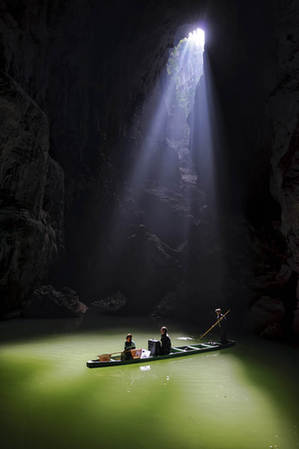| Utopian Sojourn
By XIE GANG
|
 |
|
The limestone tunnel is the only way to get in or out of Bamei. |
CELEBRATED "recluse" poet Tao Yuanming of the Eastern Jin Dynasty (316-420) was also author of the short prose work entitled A Tale of Peach Blossom Valley. It tells of a mountain-encircled land removed from temporal existence, laced with crystal-clear rivers and girded with bridges, whose inhabitants live a carefree life of peace and prosperity. The Chinese title of this work Taohuayuan Ji has since been synonymous with Utopia.
A fisherman of the Taiyuan period of the Eastern Jin Dynasty is the character that unexpectedly discovers the unearthly realm depicted in A Tale of the Peach Blossom Valley. After rowing further than usual along a stream he comes upon a grove of blossoming peach trees whose dazzling petals are strewn along its velvety green banks for several hundred yards. Intrigued as to exactly what kind of place he has stumbled upon, he carries on rowing to see where it leads. Finding the river's source at the end of the peach grove, he spies an opening at the foot of a mountain. On entering, the passage is so narrow he can barely advance, but after a short distance it broadens out to reveal a vast, spacious locale of tastefully built houses, fields full of crops, limpid pools and luxuriant mulberry, bamboo and willow trees. Paths lead through the fields in all directions, and the farmyard cacophony of chickens, dogs and pigs aptly accompanies local inhabitants as they work happily in the fields while grandparents and children keep one another company in the homestead.
People have sought the place that Tao Yuanming describes in A Tale of the Peach Blossom Valley ever since. There is no consensus on its setting. Some say it is the Peach Blossom Cave in Hunan Province, some that it is at the foot of Shang Mountain in Shangluo City of Shaanxi Province. Other suggested Utopian localities include Kangwang Valley of Mount Lu in Jiangxi Province, Jiande of Hangzhou in Zhejiang Province, Yangshuo of Guilin in Guangxi Zhuang Autonomous Region, Huaiji of Zhao-qing in Guangdong Province, and Bamei Village of Guangnan County in Yunnan Province. One factor uniting these claims is that a grove of blooming peach trees is commonly perceived as a bucolic ideal, particularly from a contemporary perspective.
|
